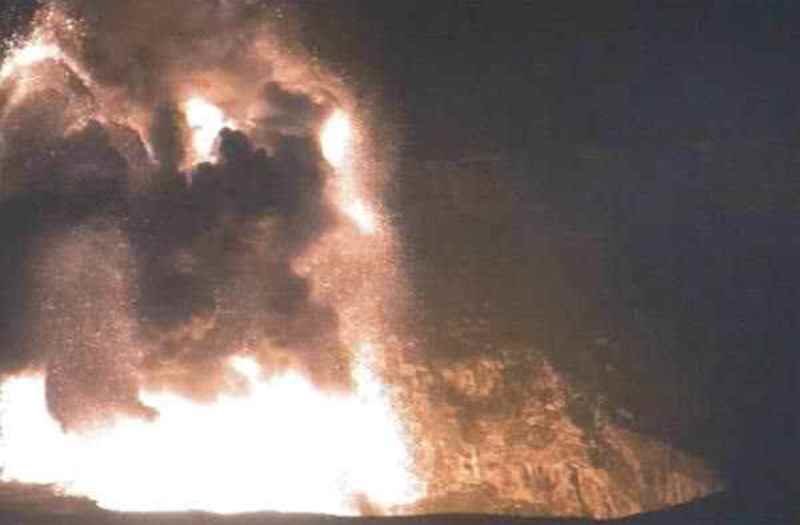
Since Saturday, there have been three such rockfalls resulting in small explosions at the summit lake, said Janet Babb, a geologist with the USGS Hawaiian Volcano Observatory.
"When the lava lake rises, it heats the rock in the vent's rim, and as you know, when you heat things, things expand and the rocks crack," Babb explained, "and because it becomes unstable, periodically we see these rockfalls."
She added, "Over the past week, the level of the lava lake has been the highest it has been in the past six months."
On Christmas Eve, the lake was about 210 feet below the floor; on Nov. 29, about 165 feet below; on Oct. 15, about 260 feet below; on Sept. 16, about 236 feet below; and on Aug. 20 about 190 feet below the crater floor. This week, the lava lake level has fluctuated from about 115 feet below on Sunday to 95 feet below on Wednesday. Thursday afternoon, the level was about 112 feet below the floor of Halemaumau.
The lava lake last overflowed the Overlook vent rim sending flows across the floor of Halemaumau Crater between late April and May 9, drawing thousands of visitors looking to get a glimpse of the activity. It marked the first time the floor of Halemaumau was exposed to lava since 1982.
Friday, Babb said, the lava still remained out of sight of visitors at Jaggar Museum. However, an incandescent glow is visible at night.
The most recent rockfall and explosive event occurred early Friday. At 3:51 a.m., a section of the Overlook vent's eastern wall fell into the summit lava lake resulting in a small explosion that agitated the lake enough to light up the night sky, she said. The explosion occurs when the rocks hit the lava lake's gas-rich foam-like surface.
"There's a release of gas and that propels fragments of molten lava upward, and depending on the size of the rockfall and vigor of the explosion activity, some fragments may make it to the rim of Halemaumau," Babb said.
Scientists Friday morning reported finding fragments, including one that measured 30 centimeters, or about 12 inches, covering the old lookout on the rim of Halemaumau crater, which was closed after the Overlook vent opened in 2008.
"And that is why it remains closed," Babb said. Visitors to the park looking to get a glimpse of the activity must do so from the Jaggar Museum.
The rockfalls, which also occurred early Saturday and Monday, have happened since the vent opened in 2008 and are not a reason for concern, she said. Scientists continue to monitor the volcano and have sent personnel out in the field to collect and analyze fragments.
"This is how the vent has grown from 115 feet then to 755 feet (wide) today," Babb said.
As of Friday morning, the volcano was neither showing signs of inflation nor deflation, however, inflation had picked up Sunday before leveling off midweek. During inflation, magma rises into the summit reservoir, according to the observatory. The summit reservoir enters the deflation portion of the cycle when the magma moves laterally into a rift zone and either erupts or is stored there.
When lava was sent onto the floor of Halemaumau in 2015, it came amid a period inflation at the summit.



Reader Comments
to our Newsletter